*NURSING > QUESTIONS & ANSWERS > Kaplan University - HA 515 Leadership End of Chapter Case Studies (FROM CHAPTER 1- 26) GRADED A (All)
Kaplan University - HA 515 Leadership End of Chapter Case Studies (FROM CHAPTER 1- 26) GRADED A
Document Content and Description Below
Leadership End of Chapter Case Studies Chapter 1 Case Study 1 A. What are some of the indicators that Jane was initially in the "honeymoon" phase of reality shock? How did Jane manifest characteris... tics of the "shock and rejection" phase? B. What steps could Jane take to adapt to her new environment successfully and cope with the reality shock? Case Study 4 A. What transitions have each of these nurses experienced in their stories? Which nurse is most likely to have experienced reality shock during the transition from student to nurse? B. Everybody has a story. Case Study 5 A. Based on the evidence provided in Boxes 1-1 and 1-2, how do each of the programs assist the role transition? B. All three programs have similarities and differences. Reflect on what you believe are your own learning needs during the transition period. What are the positives and negatives for each of the programs to meet your learning needs? Chapter 3 Case Studies Case Study 1 A. Judy left brain, John right brain B. What suggestions would you give Judy and John to help them study better? C. How could Judy and John create an effective study space? D. Use calendars, reminders, declutter, color code, set a day to day to do list E. Which of the suggested tactics for managing electronic communication do you currently use? Which of the tactics do you not currently use? Case Study 2 A. I think some of the things in the box would help her better manage her time and help her with her feelings of self-doubt. B. Is Leslie a right or left-brain thinker? Defend your position. C. Based on your interpretation of Leslie's type of thinker, create a list of activities for her, using the side of the brain that is dominant. Case Study 3 A. What symptoms does Joe exhibit that make him a candidate for early burnout? B. What suggestions would you give Joe to alleviate the early signs of mental and physical burnout C. Joe tells you that the transition period from student nurse to registered nurse was the worst time of his life. How would you respond? How would you turn this into a positive interaction? Case Study 4 A. What strategies could Chris's advisor explain to her that might help her overcome procrastination? B. Chris explains to her advisor that although she procrastinates, she is also a perfectionist, always wanting to earn A' on all her work. What guidance should her advisor give her? C. Chris's advisor tells her to try positive affirmations to boost her self-esteem. What is a positive affirmation, and how would it help Chris in this situation? . D. Chris explains how the online course is a lot harder than what she expected, and she is having trouble keeping up with the class. She tells her advisor that she often forgets about the assignments because the course is more self-directed than her other classes. How should her advisor help her? Chapter 3 Case Study 1 A. Which relationship best illustrates mentoring? Coaching? Precepting? B. Mentor may have a personal relationship, occurs over time, he chose to work with her. C. Of the three types of relationships, with which do you feel the most comfortable? Case Study 2 A. What qualities should Amber look for in a mentor? B. Describe the preceptor relationship in this scenario. C. Compare and contrast how a mentor would differ from a preceptor in the approach to helping Amber transition into nursing. Case Study 3 A. Of these possible mentor candidates, which would be your preference based on your understanding of mentoring? B. Identify a situation from your clinical experiences in which one of the three candidates would be preferable over the others. Chapter 4 Case Study 1 A. What are each student's clinical interests? B. What are the priorities for each student? C. What questions should each student ask to guide their employment choices? D. Describe some possible career goals based on the three students in the case study. E. What steps should Wendy take to research the organization she selected? Case Study 2 A. Did Rhonda take effective steps in beginning the job search process? B. What should Rhonda do after obtaining a job interview? C. Rhonda received interview meetings at two local hospitals. The first hospital had achieved Magnet status 3 years previously. The hospital's website described the philosophy of nursing, included a picture and profile of the chief nursing officer, and provided an organizing framework for the facility's nursing care. The second hospital, which highlighted its awards for health care from multiple organizations, had nursing opportunities available in several areas but did not provide any specific information on nursing care or leadership. Compare and contrast the two hospitals' media portrayal of nursing. D. Which type of self-reflection should Rhonda consider prior to the interviews? Case Study 3 A. Identify the positive strategies used by Andrea. B. What negative things did Andrea do that might decrease her chances of employment? Case Study 4 A. What do you think about how Mitch approached the interview? What could he have done differently B. During the interview, the recruiter asked Mitch about his weaknesses. Below are some possible responses. Discuss the pros and cons of each response: C. The recruiter also asked Mitch about his long-term future plans. Which of the following responses is the most appropriate, and why D. The recruiter asked about Mitch's qualifications that would make him successful in this position. Discuss the pros and cons of each possible response: E. Finally, Mitch was questioned about his ability to handle stress. Which of the following is the most appropriate response? F. In closing, the recruiter told Mitch that his Facebook page was viewed to gather an understanding of Mitch's background, likes, interests, and goals. Is it legal for the recruiter to gather information from Facebook? Why or why not? G. The recruiter offers Mitch a nursing position. Mitch also has another interview scheduled at another hospital tomorrow. How should Mitch respond? Chapter 5 Case Studies Case Study 1 A. Which statement by the graduate nurse is incorrect concerning the role of the National Council of State Boards of Nursing? B. Can one state's exam be more difficult than another state's exam? Defend your response. C. Would the graduate nurse be able to transfer her license? Why? The graduate nurse would be able to transfer her license if in a compact state. D. Where could Heather go to find out if what she heard was true? Case Study 3 A. Explain why Carol's dependence on her experiences from working as a nursing assistant might hinder her from responding appropriately to the first NCLEX® question. B. What error in judgment did Carol make in responding to the question concerning delegation? C. How should Carol have responded to the question concerning the nursing priority for a client with new onset of a headache? Chapter 6 Case Study 2 A. Based on what you know about nursing conditions during the Civil War, what did the first nurse mean by the remark? B. What did the second nurse imply by the statement about nursing in the Victorian Age? Case Study 3 A. Describe how Laurie demonstrated evidence of the following roles of the traditional nurse. She B. Reflect on your own experiences in nursing school. How did you demonstrate characteristics of the traditional nurse roles? Case Study 4 A. Identify the correct and incorrect descriptions of the three degrees in this scenario. B. Bob goes on to describe how his nursing career would have been much different in the Victorian Age. He explains how he would probably not be a nurse—he would be something else instead, taking care of his frail and dainty wife. He laughingly tells Ann and Carol that they would be nurses and "old maids." Explore his comments in relation to the Victorian-era nurse. C. Next, Carol tells Bob that in earlier eras, both men and women were nurses and both genders took vows of purity and chastity. What did she mean by this statement? Chapter 7 Case Study 1 A. Describe the educational requirements for each of the different educational paths (ADN, BSN, MSN). B. What should Martha expect from a traditional nursing program (BSN)? C. What are the possible master's educational paths for Ahmad? D. Jean is considering an online RN-BSN program when she completes her associate degree. What are the advantages and disadvantages of this method? Case study 3 A. How would you help Marianne with her decision based on employment opportunities within each of the advanced practice options described? B. Compare how the clinical nurse specialist and nurse practitioner educational preparation could help Marianne meet her career goals. C. Marianne's professional goals include earning a doctoral degree in nursing. Consider the DNP versus the PhD in relation to Marianne's professional goals. Which doctoral path would provide the educational preparation she would need to achieve her goal? D. Describe the differences between the DNP and the PhD. DNP program and allows work to take place with health care and public policy leaders and experts. Case Study 4 A. Can the state require nursing programs to pass accreditation standards? Yes. B. Can entry to graduate school be denied if the undergraduate degree is from a nonaccredited school? Explain your answer. C. What is the benefit of accreditation to the students? To the school? Accreditation is important because it: Helps determine if an institution meets or exceeds minimum standards of quality. D. The student in the scenario stated that accreditation certifies that the school meets state requirements for nursing education. What's wrong with this statement? Case Study 5 Link broken Chapter 8 Case Study 1 A. Did Florence Nightingale create the first nursing theory? Defend your position. B. What definition for the metaparadigm of nursing does Nightingale's theory propose? C. Compare and contrast the definitions of person, nurse, health, and environment in Nightingale's and Orem's theories. D. Review the theorists' definitions of the metaparadigm in Box 8-2. Which of the theorists' definitions fit your own beliefs about nursing? Case Study 3 A. Describe how Theresa applied aspects of Watson's theory of human caring to her nursing care of her patient? B. How would you apply Leininger's culture care theory to the care of Theresa's patient? C. Compare Watson's and Leininger's theories regarding their definitions of person, nurse, health, and environment. What is similar? What is different? Chapter 9 Case Study 1 A. How could Jeri describe how nursing organizations enhance the professional image of nursing? B. Why might Jeri expect to meet resistance by the nurses on the unit? C. Explain why it is important for nurses to understand the social impacts on the perception of the nursing profession. Case Study 3 A. Is making recommendations for care of the patient by the nurse consistent with a professional role of nursing? B. How would you respond to the wife's inaccurate understanding of the nurse's role? Chapter 10 Case Study 1 A. What management style did each of the three charge nurses (Sherrie, Linda, and Tracy) display? Give a rationale for your choices. B. What type of management style do you feel most comfortable working under as a student? C. By looking at the outcomes from each shift, describe how effective each charge nurse was based on her management and leadership characteristics. Chapter 11 Case Study 1 A. Is this the correct transcription of the order? How would you change it? B. Did you take the telephone order correctly? C. What tips for communicating with physicians on the telephone can you recall from the textbook chapter? Which of these were missing, done incorrectly, or not done during the communication with the physician? Which steps still need to be done? D. Review the previous questions. How does each contribute to patient safety? Case Study 2 A. Evaluate how the nurse giving you the report used the SBAR tool. How could the tool be used more effectively when giving this shift report? B. What critical elements of the shift report are missing? C. How would you handle this situation? What could you say to make sure you receive the information you need to care for this patient? Chapter 12 Case Study 1 A. What are the nonverbal cues from each of the participants? B. Identify the verbal and nonverbal facilitative and obstructive messages from each of the participants in this case. C. Which of the three displayed upward communication? Was it effectively handled? Why or why not? D. Joyce and Diane both took initiative in distributing the information to the necessary people. What were the positive aspects to their methods of handling the situation? What were the negatives? Case Study 2 A. What aspects of gender differences may have affected the communication between Tony and Cecilia? B. How was Cecilia assertive in her communication? C. During the first week, Cecilia mentioned that the unit director was helping Tony move into a management position in the hospital and that he would soon be taking over another unit. Tony did not know about the management position and was taken aback. How should both Tony and Cecilia handle the information obtained through the grapevine? Case Study 3 A. Which type of team was created, and why? What long-term purpose does it serve? B. What roles did each of the orientees adopt in this scenario? C. How do the roles contribute to overall team performance? they D. Which role(s) do you feel comfortable assuming as a new nurse? Present a real or potential nursing situation (people involved on the team, environment) that demonstrates the environment in which you would feel comfortable contributing to a team process. Chapter 13 Case Study 1 A. Of the five types of conflict (role, communication, goal, personality, and ethical), which applies to this case study? B. How would you initiate a discussion to promote collaboration between the two groups? C. How would you handle this situation? I would explain that it is a group of 42 students and after hearing both sides take it to a vote and let both parties know that if they can’t decide a decider will decide for them. D. Congratulations! You were able to bring both sides together in an agreement regarding the ceremony. It is now a month before the event, and you are explaining how the plans are coming along to the graduating class and asking for input into the details. You look up and note an undercurrent of tension as several students roll their eyes, yawn, and whisper derogatory comments. When you ask whether anyone has suggestions or comments, you are greeted with blank stares. How would you address this problem? E. The department chair asks you, in front of some classmates, how the plans for the ceremony are proceeding. As you begin to speak, a classmate says, "She's pretty controlling, so you know, of course, everything's already taken care of." How would you address this person? F. You ask your classmates each week for help in planning the event. So far, only three students have volunteered to assist. As time draws nearer, you become increasingly angry and feel resentment toward your classmates. After all, you are spending a lot of valuable time planning a ceremony for the entire class. What is the cause of your anger? How could you effectively manage the anger? Chapter 14 Case Study 1 A. Did Sam appropriately delegate in this scenario? B. The aide misunderstands Sam's instructions and instead ambulates the patient in Room 234, who is 3 days post-hysterectomy and has been walking in the halls for 2 days. Where did the breakdown in communication occur? C. Who would be accountable for the outcomes if the patient in Room 234 had fallen and broken a hip during ambulation? Would it be Sam, who directed the aide to ambulate the patient in Room 244, or the aide, who ambulated the patient in Room 234? Case Study 2 A. What went wrong in this scenario? B. How were the five rights applied to this scenario? C. Who retains accountability for the outcome? Why? Chapter 15 Case Study 3 A. What are the three patterns of nursing care delivery described? B. Which of the patterns described would benefit the intensive care patient? Why? patient focused care model. C. Although each of the various models works toward quality patient care, which pattern of care delivery makes the best use of available resources? Case Study 6 A. How is this an example of Transforming Care at the Bedside? making B. How does this example promote nurse retention and satisfaction? C. How does this initiative fit with the Forces of Magnetism? Chapter 16 Case Study 3 A. How did Anita ensure fiscal responsibility to the patient? B. What concerns should Anita have regarding the information obtained during admission C. Which issues of fiscal responsibility are raised by the physician's orders? if the patient can D. During discharge, Anita reviews the list of new medications prescribed for the patient. Almost every medication the patient was previously taking has changed in dose or has been replaced by a different medication. What can Anita do to ensure that the patient has the means to obtain the new medications and that she understands how to take them? Chapter 17 Case Study 1 A. Describe how the nurses used political strategies to influence the decision. B. How does this case reflect the political power of nurses? C. How did the nurses demonstrate the political skills described in the text? D. What was the purpose behind the nurses forming a coalition? Case Study 2 A. What is the purpose of gathering support for the bill from fellow nurses? B. What are the nursing benefits of the interstate licensure compact that could be emphasized in meetings with or letters to the representatives? C. What are some strategies to keep in mind when addressing the representative during a meeting? In a letter Chapter 18 Case Study 2 A. Describe the benefits of Magnet designation for a hospital. B. What effect does seeking or receiving Magnet designation have on the organization’s position on the role of professional nurses as it affects professional practice? C. What are the possible concerns of the nurses in Jake's hospital regarding shared governance? Case Study 4 A. Is implementing a shared governance model by the hospital enough to address the issues voiced by the nurses? Why or why not? B. The medical surgical unit has strong participation on the committees and collective bargaining unit. The telemetry unit only has 3 out of 32 total nurses who actively participate. The telemetry unit has six open nursing positions that are not filled, so many of the nurses to work overtime. What are some of the factors affecting participation on the telemetry unit? C. Is it the responsibility of the hospital to encourage and support the telemetry unit nurses to participate in collective bargaining? D. A nurse from the telemetry unit tells Michelle that she should be ashamed of herself and her unit for putting up barriers to professional nursing practice, setting the profession back 50 years. How should Michelle respond? Chapter 19 Case Study 3 A. Do you think that there is an issue involving the allocation of health care resources in this case? Would your response change if the parents were indigent? B. The insurance company will not cover another pregnancy based on the first child’s problems, not on the genetic testing itself. Do you think that the parents’ rights are compromised because of the insurance company’s decision? C. Does the insurance company have a right to the results of the genetic testing since they paid for it? Case Study 4 A. The International Code for Nurses states, "The fundamental responsibility of the nurse is fourfold—to promote health, to prevent illness, to restore health, and to alleviate suffering." Did the nurses in this scenario follow the code for nurses in caring for the wife? B. Did the nurses in this scenario follow the code statement in caring for the husband? Was it their responsibility to include the husband in the care provided for the wife? C. How does veracity, the duty to tell the truth, apply to this scenario? Was it overlooked in the care given to the husband and/or wife? Were there additional actions that should have been taken? Chapter 20 Case Study 1 A. Does this scenario meet the basic elements of malpractice? Explain. B. If you were working or volunteering at a first aid station and this scenario occurred, would the basic elements of malpractice apply? . C. If you are the first aid nurse in this scenario, what specific actions should you take immediately following the accident? Case Study 2 A. Who is liable for the actions of the student nurse—you (because you gave the medications), the staff nurse (who checked the medications), or the instructor (who was supervising)? B. Did the instructor meet the standards for supervisory liability? C. Suppose you had requested supervision for the medication administration but could not find your instructor. Who would be liable in this case and why? Chapter 21 Case Study 1 A. What barrier to cultural care does Mark exhibit? B. What could Mark do to increase his cultural knowledge? C. How could Mark increase his cultural skill? D. Describe how the CULTURE approach (Box 21-1) could increase Mark's cultural competence. E. What responsibility does the employer (hospital) must ensure cultural competence resources for all patient care providers? Case Study 2 A. Identify how Laurel exhibits spirituality. B. What could Connie do to assess Tina's sense of meaning or purpose? C. Which organizations address the patient's right to respect for cultural and spiritual values? How do they promote their positions? D. Review Box 21-6 (Dimensions of Spirituality with Corresponding Assessment Questions) in the text. How would you feel asking the questions of Laurel? How would you feel asking the questions of Tina? E. If Tina were of Chinese heritage, how might this explain her perceptions of and attitudes about her illness? F. Laurel is of Native American heritage. How does this affect her spirituality? Strong Chapter 22 Case Study 4 A. Would it be appropriate to conduct a root cause analysis or failure mode effects analysis on this issue? B. Define the problem in this case scenario. C. What is the key performance indicator in this case? D. Analyze possible factors leading to ideal ambulation and actual ambulation. Case Study 5 A. You are head of the QI team investigating the nurse-sensitive indicators. What are the key performance indicators? B. What steps are essential to ensure that no further VAPs occur? C. It is identified that the primary problem contributing to the number of VAPs is that the head of bed is not always elevated to 30 degrees. The benchmark for this indicator is 20%. Of what is this an example? Chapter 23 Case Study 3 A. Which system would be better for the Baxter’s' lifestyle, an EMR, EHR, or PHR? B. What are the pros and cons of having the entire health record computerized? C. Because Mr. Baxter uses a larger pharmacy, he receives notices to his smartphone for reminders to have blood work done and prescriptions refilled. An app allows him to view his medication timing, side effects, and other information. How do these functions reinforce the delivery of safe and effective health care? Case Study 4 A. Is Joan and Lisa's project considered e-health? B. What suggestions would you make to assist Joan and Lisa in creating an e-health website? C. Now that Joan and Lisa have experience creating a website of their own, their instructor asks them to provide some tips to other students for evaluating websites Chapter 24 Case Study 2 A. Why might you be meeting resistance from nurses? B. Should this resistance have been anticipated? Yes, C. What steps could be taken to encourage the nurses to adopt the practice change? Case Study 5 A. You are a member of the education-research committee at your facility and have been asked by nursing administration to examine the effectiveness of human-patient simulation in preparing new graduates to assist in a code-arrest. Using a quantitative approach, develop a research question that would examine this research problem. Chapter 25 Case Study 1 A. How should Angie have approached moving the patient? B. What did Angie do correctly in this situation? she reviewed the proper notes on moving her patient. C. Explain why back problems are the number-one cause of nurse injuries and describe the subsequent effects on nursing care. D. Describe how the "safe patient handling" legislation enacted in Texas might have prevented the injury. Case Study 3 A. What is a Code White, and how would it help in this situation? B. Identify elements of this case that signal a potentially threatening situation. C. What preventive measures does the facility have in place to deal with hostile situations? D. If Amanda were floated to another floor where this situation occurred, would this change how she should approach the situation? Chapter 26 Case Study 4 A. Does the Joint Commission have the authority to cite the hospital for noncompliance with NIMS? B. Why was the hospital cited for noncompliance? C. What is the benefit to the hospital of using the Hospital Incident Command System (HICS) under NIMS? Case Study 5 A. How is triage used to screen patients appropriately in this scenario? B. Using the list in Box 26-2 in the text, what were the epidemiological clues presented in this scenario? C. Why is it important to monitor health signs, symptoms, and complaints of the population? D. It is determined that a rare insect caused the flu-like symptoms and epistaxis. What resources are available to the hospital to treat this outbreak? [Show More]
Last updated: 1 year ago
Preview 1 out of 20 pages
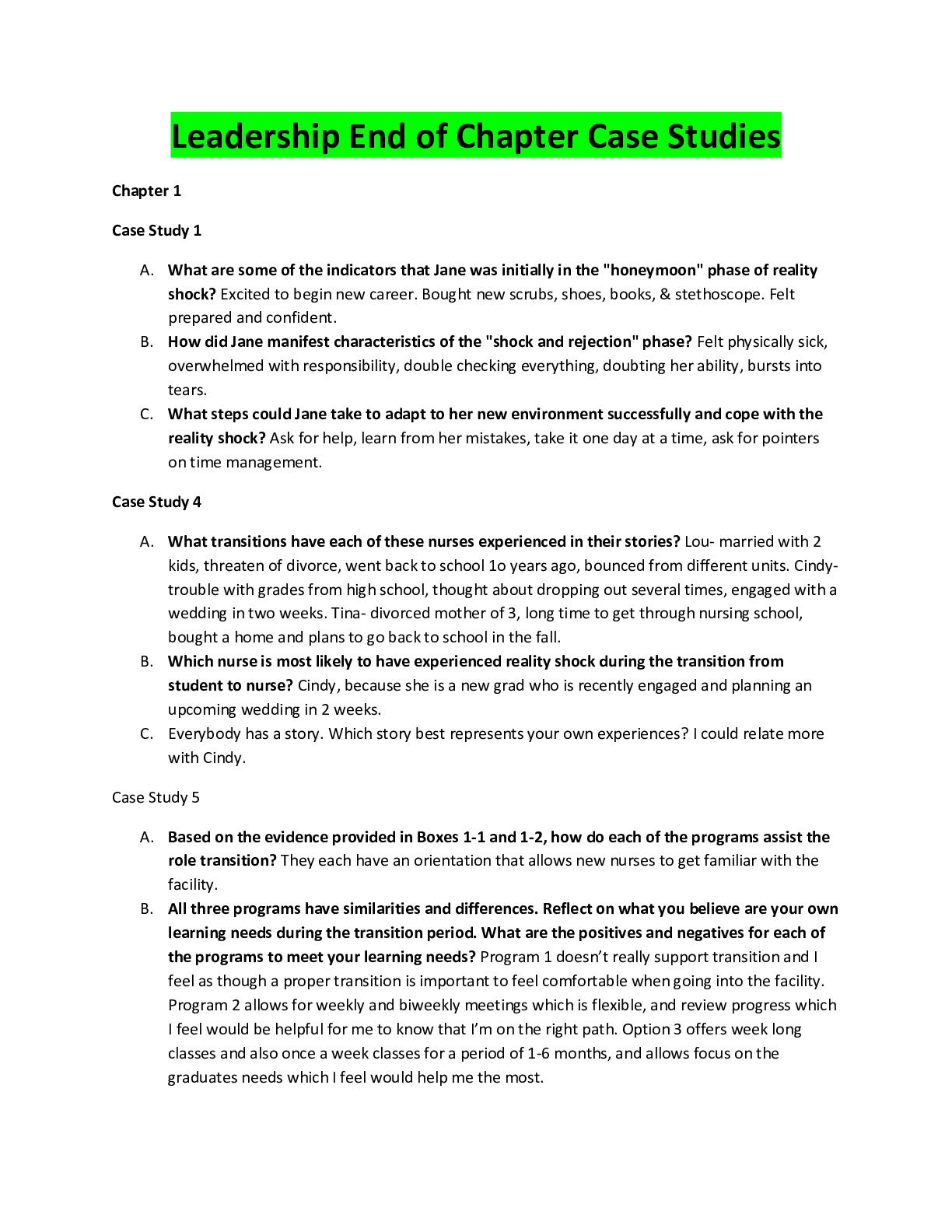
Reviews( 0 )
Document information
Connected school, study & course
About the document
Uploaded On
Apr 25, 2020
Number of pages
20
Written in
Additional information
This document has been written for:
Uploaded
Apr 25, 2020
Downloads
0
Views
125













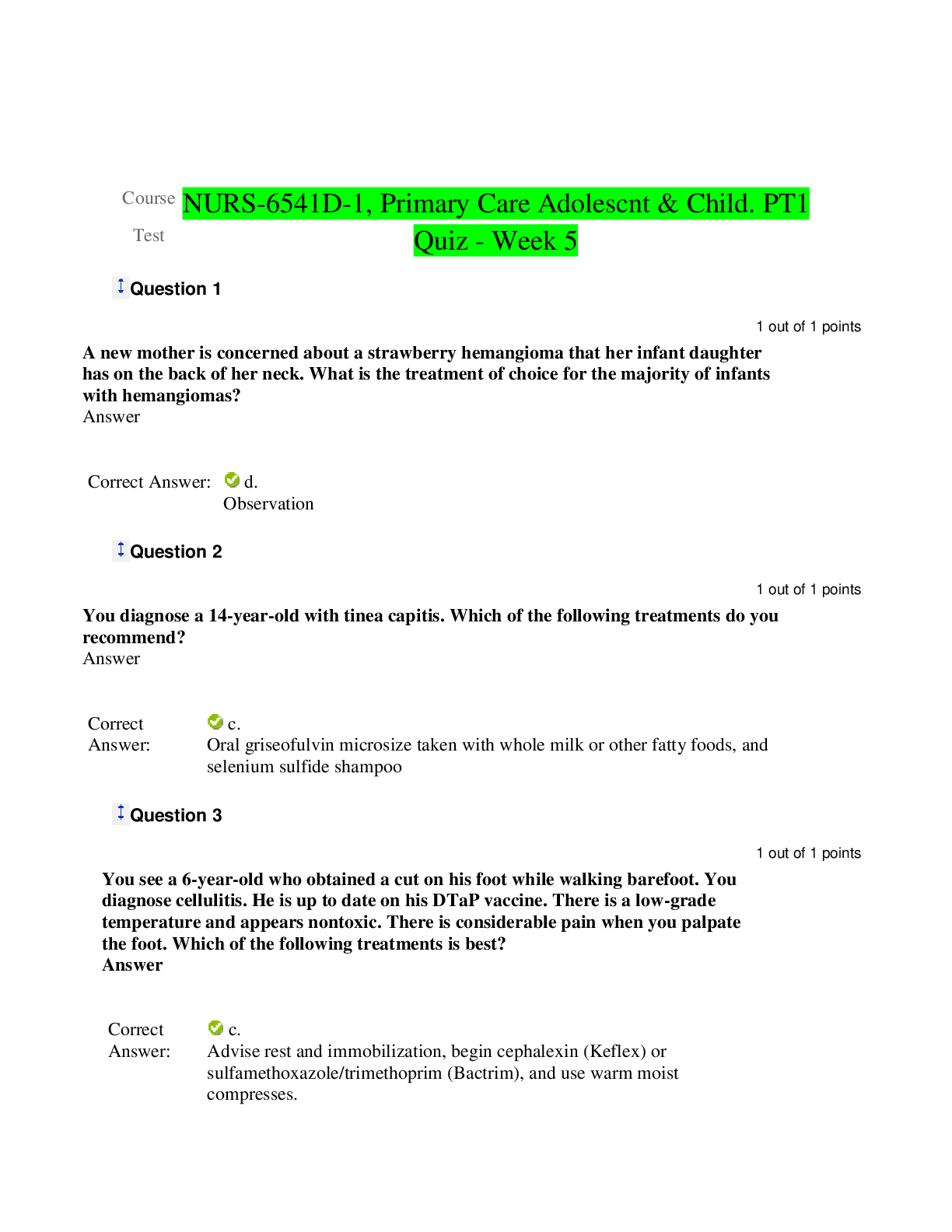


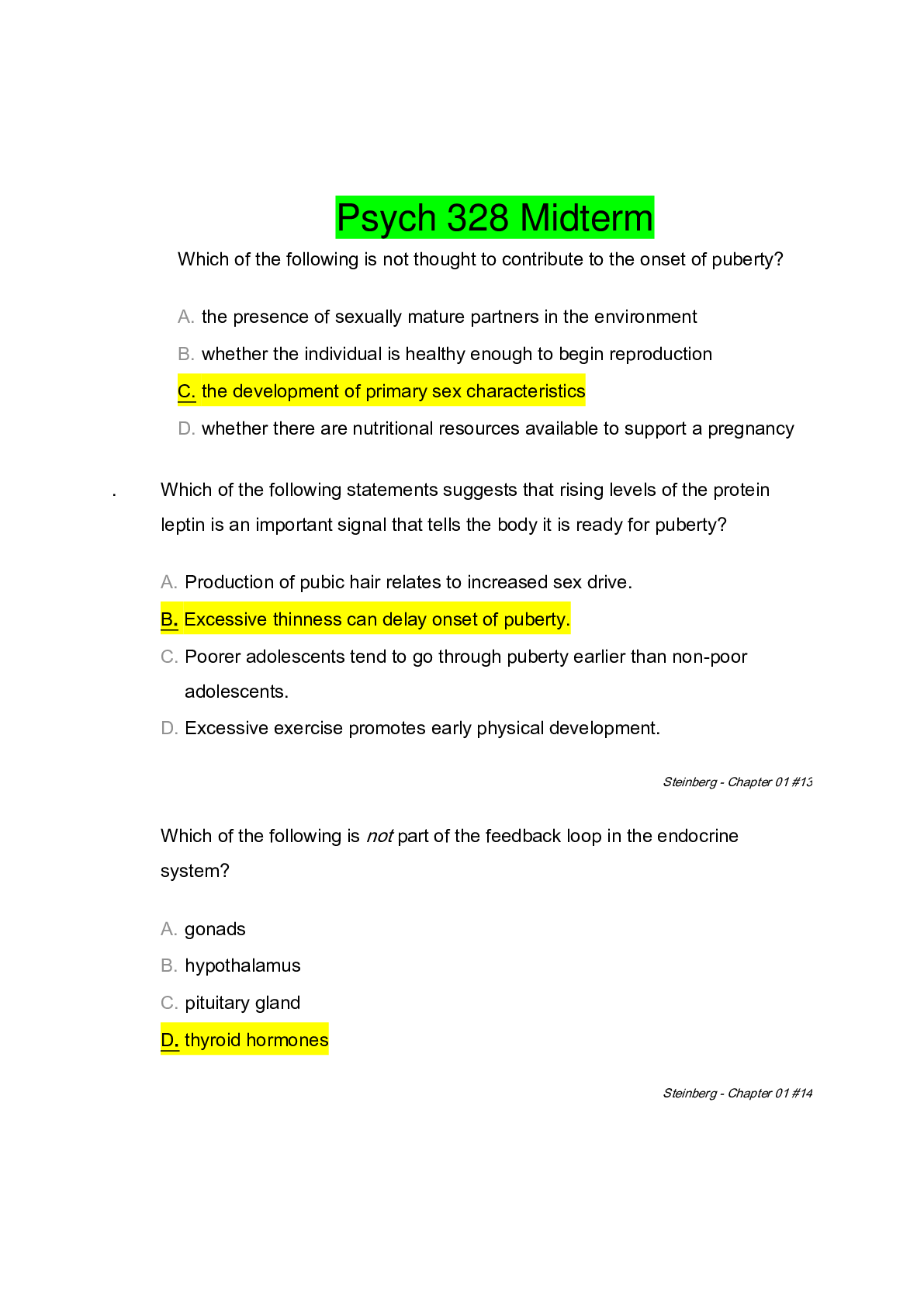
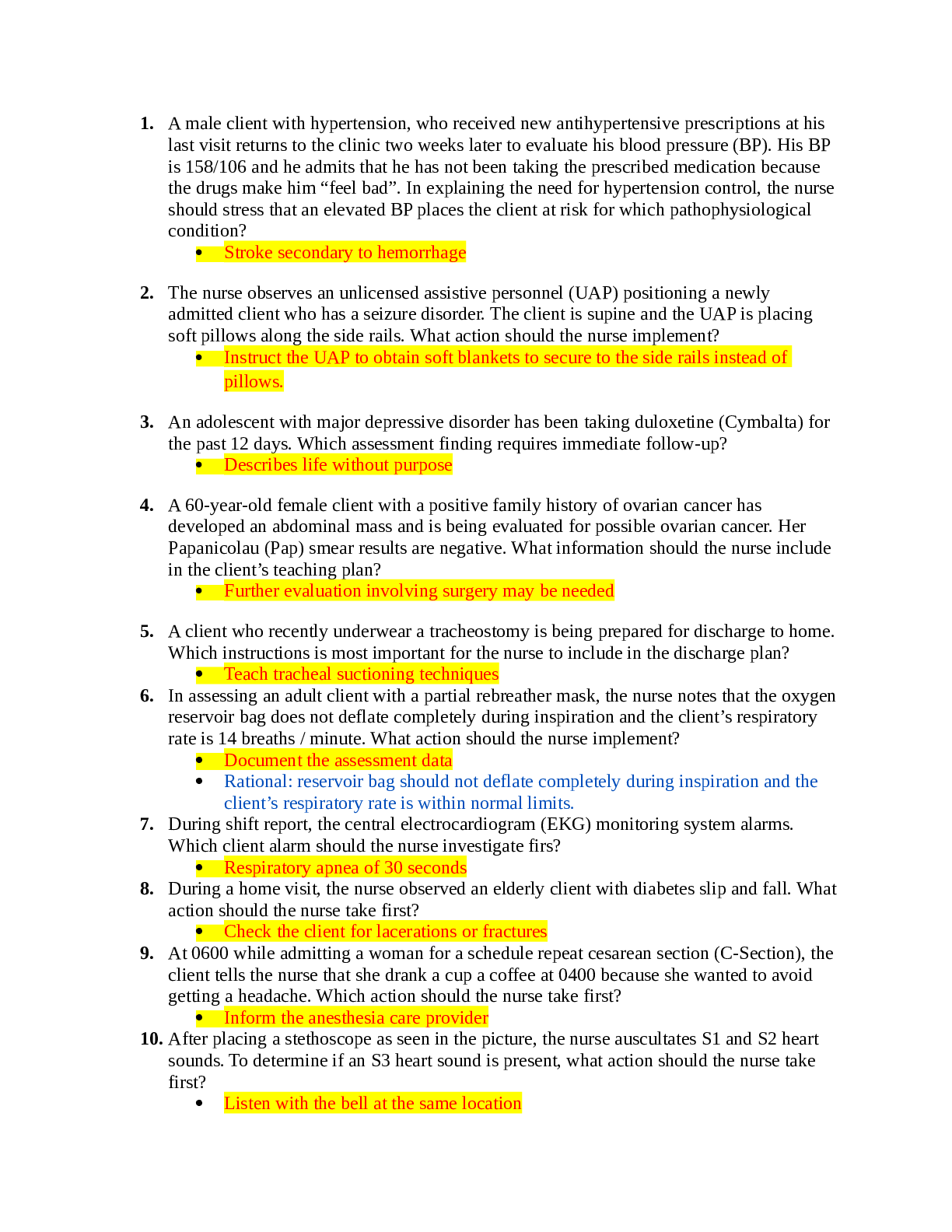

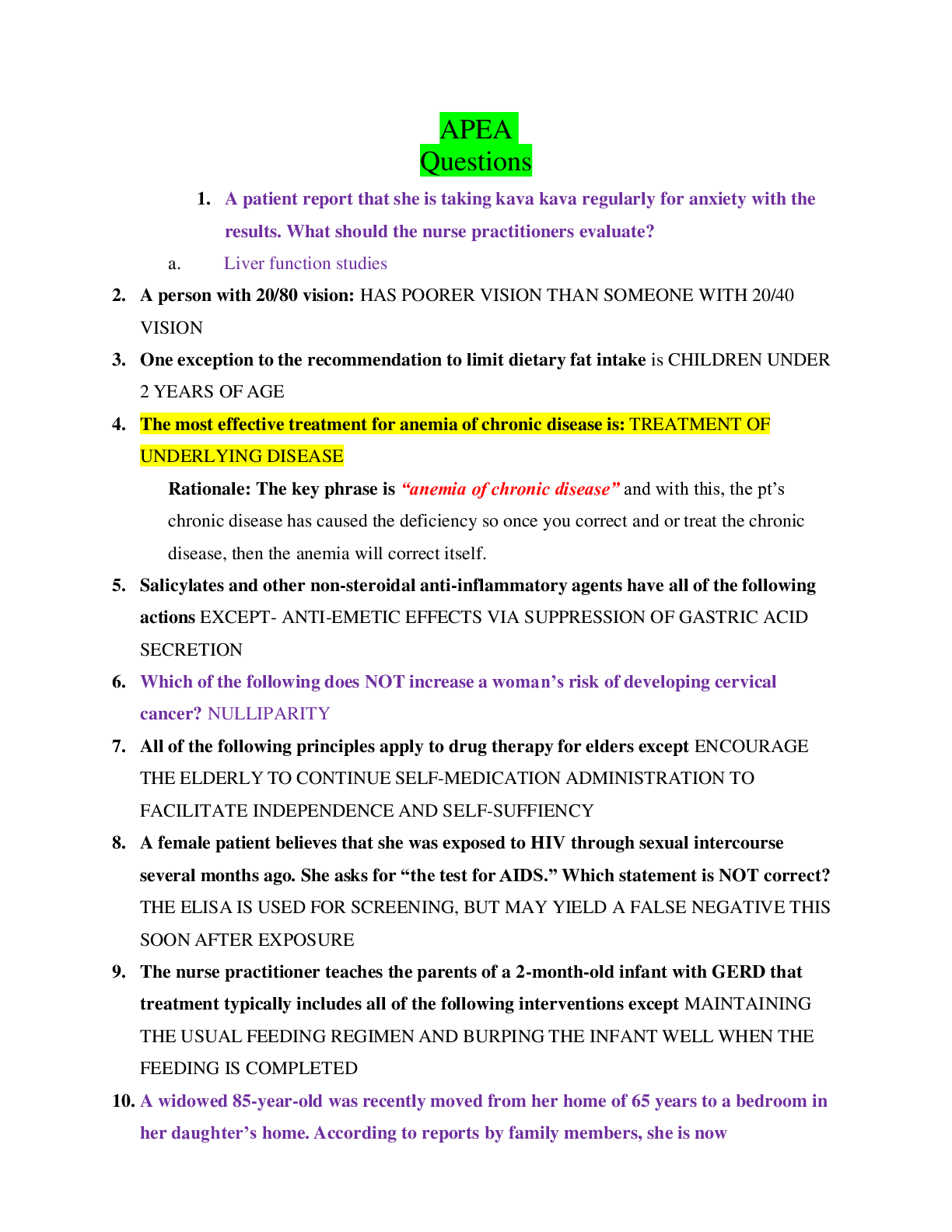




.png)

.png)




.png)
.png)

.png)



